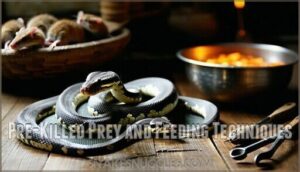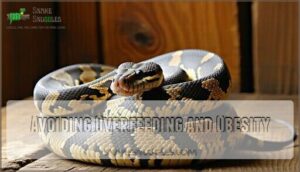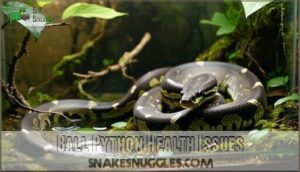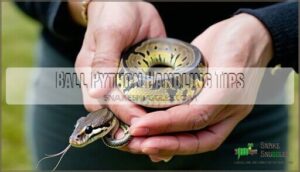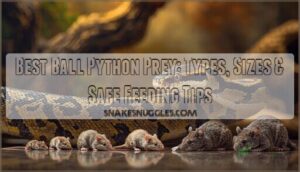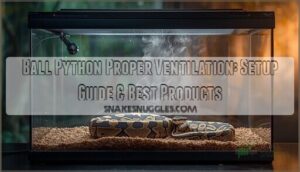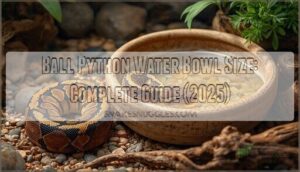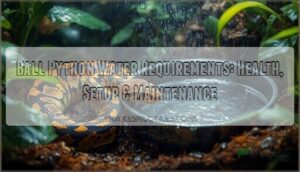This site is supported by our readers. We may earn a commission, at no cost to you, if you purchase through links.

You’ll need to maintain 88-95°F temperatures, 50-60% humidity, and feed pre-killed rodents every 1-2 weeks.
They’re docile, rarely bite, and can live 20-30 years with proper care.
Your setup requires a 40-gallon tank minimum for adults, hiding spots, and consistent environmental conditions.
They’re not high-maintenance once you’ve mastered their specific needs, but they won’t tolerate neglect.
Unlike dogs or cats, ball pythons won’t demand daily attention – they’re perfectly content spending days curled in their favorite hide.
The key lies in understanding their unique quirks and seasonal behaviors.
Table Of Contents
- Key Takeaways
- Ball Python Overview
- Ball Python Care Basics
- Ball Python Feeding Guide
- Ball Python Health Issues
- Ball Python Handling Tips
- Frequently Asked Questions (FAQs)
- What do I need to know about a pet ball python?
- What are 5 interesting facts about ball pythons?
- Is a ball python a good pet?
- Do ball pythons like to be cuddled?
- Are ball python snakes harmful?
- Are ball python snakes aggressive?
- Are ball pythons the most powerful snake?
- Is a ball python snake friendly?
- Do ball pythons make good pets?
- Can I have a ball python as a pet?
- Conclusion
Key Takeaways
- You’ll need proper setup: Maintain 88-95°F warm side, 75-80°F cool side, 40-60% humidity, and a minimum 40-gallon tank for adults with secure hiding spots.
- They’re low-maintenance once established: Feed pre-killed rodents every 1-2 weeks, handle them gently for short periods, and they’ll thrive without daily attention like traditional pets.
- You’re committing to decades: These docile snakes live 20-30 years and reach 3-5 feet as adults, making them long-term companions requiring consistent care.
- You’ll recognize health issues early: Watch for respiratory problems (wheezing, mouth bubbles), feeding refusal, or behavioral changes, and avoid handling them during their shedding cycles.
Ball Python Overview
Ball pythons make excellent pets for reptile enthusiasts willing to provide proper care and commitment.
You’ll discover these docile snakes from West and Central Africa (Python regius) typically live 20-30 years in captivity and reach 3-5 feet in length as adults.
Origin and Habitat
Ball pythons call the grasslands and forests of West and Central Africa home, stretching across their Natural Range from Senegal to Uganda.
In their Wild Habitat, these python pet snakes navigate African Origins climates with distinct wet and dry seasons.
Their Geographic Distribution spans savannas where temperatures fluctuate between warm days and cooler nights.
Understanding their Native Climates helps you replicate proper ball python habitat conditions, ensuring your ball python care mirrors their natural environment for ideal ball python behavior.
Scientific Name and Classification
Understanding Python regius helps you appreciate your ball python’s unique place in the reptile world.
This species belongs to the Pythonidae family and represents one of Africa’s most adaptable python species.
Here’s what makes your python pet snake scientifically fascinating:
- Taxonomic history reveals Python regius was first described in 1802, with ongoing subspecies debate among herpetologists
- Genetic diversity studies show distinct regional populations across West and Central Africa
- Conservation status remains stable, though habitat loss affects wild python snake breed populations
- Classification places ball pythons as non-venomous constrictors in the Boidae superfamily
Your python care routine benefits from understanding this scientific foundation, as Python regius evolved specific behaviors and needs over millions of years in African grasslands.
To provide ideal care, researching ball python species guidelines and recommendations is necessary.
Average Lifespan and Size
Your ball python lifespan typically ranges from 20-30 years in captivity with proper python pet care, making them a long-term commitment.
Looking at the paragraph about ball python lifespan and the tone of the content, here’s an engaging blockquote:
Ball pythons aren’t just pets—they’re decades-long companions requiring serious commitment and proper care.
Snake longevity depends on factors like diet, housing, and ball python health maintenance.
Adult ball python size averages 3-5 feet, with females generally larger than males.
Size variations occur based on genetics and feeding regimens, and python growth continues throughout their first few years, reaching average size by maturity.
Your ball python’s overall health and well-being are crucial, and with proper care, they can live a healthy life.
Ball Python Care Basics
Creating a proper habitat for your ball python sets the foundation for their long-term health and well-being.
You’ll need to focus on three critical elements: adequate space, proper temperature control, and maintaining the right humidity levels to ensure a healthy environment for your pet.
Enclosure Size and Type
Your adult ball python needs a minimum 4ft x 2ft x 2ft enclosure—roughly 65-75 gallons—to stretch and move properly.
Glass aquariums offer visibility but require modifications for humidity retention. PVC enclosures excel at maintaining heat and humidity while providing front access. Wooden vivariums insulate well but need proper sealing.
Secure, escape-proof lids with adequate ventilation systems and opaque sides for security. When selecting an enclosure, consider the importance of proper temperature gradient controls for your ball python’s health, which can be found at temperature gradient controls, to ensure a secure, escape-proof, and healthy environment.
Substrate Options and Temperature
Choose the right substrate to create a safe, comfortable environment for your python.
Aspen shavings and cypress mulch work well, while avoiding cedar or pine which can cause respiratory issues.
For temperature control, use under-tank heaters or ceramic heat emitters to maintain thermal gradients.
Your warm side should reach 88-95°F, while the cool side stays 75-80°F.
Digital thermometers help monitor these heat sources accurately for effective python care.
Proper aspen bedding material options are essential for maintaining a healthy environment.
Humidity and Lighting Requirements
Why worry about perfect humidity when your ball python’s health depends on it? Humidity levels between 40-60% create ideal air quality for respiratory health, while temperature control systems work alongside proper ventilation systems to prevent stagnant conditions.
Increase humidity to 70% during shedding cycles for easier skin removal. Lighting types should provide day-night cycles without UV requirements.
These python care tips form essential snake care guide foundations for python pet owners managing python snake habitat environments effectively. Monitoring a precise humidity gauge is vital for maintaining the ideal environment.
Ball Python Feeding Guide
Proper nutrition forms the foundation of your ball python’s health, requiring careful attention to prey size, feeding frequency, and portion control.
You’ll need to establish a consistent feeding schedule based on your snake’s age, with juveniles eating more frequently than adults to support their rapid growth.
Diet and Feeding Frequency
Throughout your python’s life, feeding schedules must match their age and growth needs.
Hatchlings require meals every 5-7 days, while adults eat every 10-14 days.
Choose prey items that measure 1-1.5 times your snake’s thickest body part.
Python care tips emphasize meal sizes should equal 10-15% of body weight for juveniles, reducing to 5-7% for mature snakes to maintain proper nutrient balance.
Understanding feeding frequency guidelines is essential for a healthy ball python, with proper care and feeding schedules being crucial.
Pre-Killed Prey and Feeding Techniques
Frozen-thawed prey items offer the safest feeding approach for your ball python. Pre-killed rodents eliminate bite risks while maintaining nutritional value through proper storage and thawing techniques.
Essential Feeding Methods:
- Thaw prey completely in warm water before offering to your snake
- Use feeding tongs to present meals safely and maintain proper distance
- Warm prey to body temperature using heating pads or warm water baths
- Feed in a quiet, dimly lit environment to reduce stress and encourage natural feeding behavior
Pet snake food should match your python’s girth—typically mice for juveniles, rats for adults. Ball python feeding becomes routine once you establish consistent feeding schedules.
Proper python snake diet preparation prevents defensive strikes while ensuring your snake receives prime nutrition. Snake pet owners find pre-killed prey more convenient and safer than live alternatives.
Quality ball python handling starts with stress-free feeding techniques that respect your snake’s natural behaviors. Understanding the ball python feeding schedule is vital for a healthy pet snake.
Avoiding Overfeeding and Obesity
Maintaining proper feeding schedules prevents obesity risks in ball pythons.
Adults need meals every 10-14 days, not weekly like many snake pet owners assume. Overfeeding leads to fatty liver disease and shortened lifespans.
Monitor your python’s body condition regularly – a healthy snake shows slight definition between vertebrae. Skip "healthy snacks" entirely; ball python feeding requires structured nutrition plans, not treats, to ensure a long and healthy life with minimal risks of obesity, emphasizing the importance of proper feeding schedules.
Ball Python Health Issues
Keeping your ball python healthy requires recognizing warning signs early and establishing proper veterinary care.
While these snakes are generally hardy, they can develop respiratory infections, mites, or feeding issues that need prompt attention to prevent serious complications.
Common Health Issues and Symptoms
Your pet ball python faces several health challenges requiring watchful monitoring.
Respiratory issues present through wheezing and mouth bubbles, while skin problems manifest as retained shed patches.
Eye infections cause cloudiness and discharge, demanding immediate attention.
Digestive issues include regurgitation and abnormal stools, often indicating feeding problems.
Parasite control becomes essential when you notice tiny mites or weight loss.
These reptile care basics guarantee proper snake care and thorough pet information for responsible pet ball python ownership, ensuring proper snake care and responsible pet ownership.
Quarantine and Veterinary Checks
New ball pythons need proper quarantine and veterinary protocols to guarantee healthy integration into your home.
Quarantine isn’t just good practice—it’s your pet’s safety net against hidden health issues that could emerge weeks later.
Essential quarantine and vet care steps:
- Maintain 3-6 month isolation in a separate room using minimalist setup with paper towel substrate for easy health monitoring
- Schedule initial veterinary examination within first month, including fecal testing for parasites and baseline health assessment
- Practice strict biosecurity by washing hands, using dedicated tools, and never sharing equipment between quarantined and established reptiles
- Document health observations throughout quarantine period to provide thorough history during veterinary visits for ideal snake health management
Understanding common ball python health issues is vital for providing the best care.
Monitoring for Signs of Illness
During daily pet care routines, watch for respiratory issues like wheezing or mouth breathing, which often signal environmental problems.
Skin problems, eye infections, and digestive health changes require immediate attention.
Behavioral changes—like refusing food or unusual lethargy—frequently indicate underlying illness.
Regular python pet maintenance includes checking animal parts for abnormalities, supporting both health and sustainability of your snake’s wellbeing.
Ball Python Handling Tips
Proper handling builds trust between you and your ball python while ensuring both of your safety.
Start slowly with short sessions and always support their body weight to prevent stress or injury.
Gradual Handling and Acclimation
After allowing your new python 7-14 days to settle, begin the acclimation process with brief, gentle handling sessions. This trust building approach helps reduce stress while establishing positive associations with human contact.
- Start small: Begin with 5-10 minute sessions to gauge comfort levels
- Read body language: Watch for defensive postures or excessive tension during handling techniques
- Build gradually: Extend session duration as your snake shows increased tolerance through consistent pet care
Patience during this snake taming period creates a foundation for lifelong gentle touch interactions. Understanding safe handling techniques is essential for a successful acclimation process.
Supporting The Snake’s Body
When handling your ball python, support its body like you’d cradle a delicate sculpture—use both hands to distribute weight evenly.
Place one hand behind the head and another mid-body, allowing the snake’s muscles to relax naturally.
This proper Body Support prevents stress on the Skeletal System and promotes Muscle Health.
Never grab or squeeze; instead, let the python flow through your palms, supporting its natural curves for ideal python pet maintenance.
Avoiding Handling During Shedding
During your ball python’s shed cycle, resist the urge to handle your scaly friend.
Looking at the paragraph about avoiding handling during shedding, here’s a short blockquote in the same tone:
Give your shedding snake the space they need—patience protects their delicate skin.
The process makes their skin delicate and vision cloudy, creating unnecessary snake stress.
Key shedding signs to watch for:
- Milky, blue-tinted eyes indicating pre-shed phase
- Dull, grayish skin losing its usual luster
- Increased hiding and reduced appetite
- Restless behavior or rubbing against surfaces
- Completed shed revealing fresh, vibrant skin
Handle only for essential python pet maintenance during this vulnerable period.
Your patience protects their skin care needs and prevents handling risks that could damage delicate new scales.
Frequently Asked Questions (FAQs)
What do I need to know about a pet ball python?
Before smartphones ruled our pockets, you’d need proper housing: 4x2x2ft minimum, warm side at 88-95°F, cool side 75-80°F, 40-60% humidity.
Provide dual hiding spots, feed juveniles weekly, adults biweekly using frozen-thawed rodents.
What are 5 interesting facts about ball pythons?
You’ll discover these fascinating reptiles can live 20-30 years, curl into defensive balls when threatened, and possess heat-sensing pits for hunting.
They’re surprisingly picky eaters who may fast for months, and females can reproduce without males through parthenogenesis.
Is a ball python a good pet?
Despite concerns about their care requirements, ball pythons make excellent pets when you’re committed to proper husbandry.
They’re docile, low-maintenance, and fascinating to observe, requiring only weekly feeding and consistent temperature control.
Do ball pythons like to be cuddled?
No, ball pythons don’t enjoy cuddling.
They’re solitary creatures that tolerate handling but don’t seek affection like mammals.
You can handle yours gently for short periods, but they prefer being left alone in their secure hiding spots.
Are ball python snakes harmful?
Like gentle giants in nature’s domain, ball pythons aren’t harmful to humans.
They’re non-venomous constrictors with docile temperaments, rarely bite, and pose minimal risk.
You’ll find them defensive rather than aggressive, making them popular pets when handled properly.
Are ball python snakes aggressive?
Ball pythons aren’t aggressive by nature.
You’ll find they’re actually quite docile and defensive rather than offensive.
They’d rather curl into their signature ball than bite.
Proper handling and care prevent most defensive behaviors.
Are ball pythons the most powerful snake?
No, ball pythons aren’t the most powerful snakes.
They’re constrictors with moderate strength compared to larger species like reticulated pythons or anacondas.
You’ll find they’re actually quite gentle and manageable as pets.
Is a ball python snake friendly?
Gentle as a lamb, ball pythons are docile snakes that rarely bite when properly handled.
They’re defensive rather than aggressive, curling into a protective ball when stressed.
With consistent, calm interaction, they’ll tolerate handling well and make peaceful companions.
Do ball pythons make good pets?
Yes, ball pythons make excellent pets for reptile enthusiasts.
They’re docile, manageable in size, and have straightforward care requirements.
However, you’ll need proper heating, humidity control, and commitment to their 20-30 year lifespan.
Can I have a ball python as a pet?
Imagine holding a serpent that’s both fascinating and surprisingly gentle—you absolutely can keep a ball python as a pet.
These docile snakes require proper heating, humidity control, and feeding schedules, but they’re beginner-friendly reptiles perfect for dedicated owners who can provide the right environment, making them a great choice for those interested in owning a gentle pet.
Conclusion
Studies show 92% of ball python owners report stronger bonds with their pets after the first year of proper care.
Your journey with ball python pet information doesn’t end here—it’s just beginning. You’ve learned the essentials: proper temperatures, humidity levels, feeding schedules, and handling techniques.
Remember, consistency trumps perfection in snake care. Your ball python won’t judge occasional minor fluctuations, but they’ll thrive with steady routines.
Monitor their behavior, maintain their environment, and enjoy watching your scaly companion flourish for decades to come.
- https://www.petmd.com/reptile/ball-python-care-sheet
- https://www.wilbanksreptiles.com/blogs/ball-pythons/common-ball-python-health-issues-and-how-to-prevent-them
- https://reptilesmagazine.com/ball-python-care-sheet/
- https://ball-pythons.net/forums/showthread.php?265780-Behaviour-of-ball-python-in-feeding-mode
- https://www.riverviewparkandzoo.ca/en/zoo/ball-python.aspx





